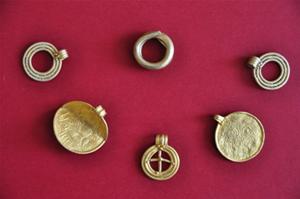BURDAG, POLAND—Nearly 100 cremation burials have been discovered during excavations in Burdąg, Poland by archaeologists from the Institute of Archaeology of the University of Łódź, says a report in Science and Scholarship in Poland. In the graves the team found a surprising number of artifacts both of a more expected sort, such as pottery, as well as some rarer items including tinder and flint with the remains of the fabric they had been wrapped in, a Frankish glass vessel fragment, and several knives with their wooden handles preserved. Team leader Mirosław Rudnicki believes that only 10 percent of the necropolis has been excavated thus far and that the burial site was used by a large population during the sixth and seventh centuries A.D. "The local population probably functioned as part of a tribal structure, distinguished by wealth and extensive contacts. These contacts, evidence of which has also been discovered in Burdąg, included Scandinavian, Frankish, Slavic, and Avar areas,” says Rudnicki.
Thursday, September 25, 2014
Early Medieval Cemetery at Burdąg
BURDAG, POLAND—Nearly 100 cremation burials have been discovered during excavations in Burdąg, Poland by archaeologists from the Institute of Archaeology of the University of Łódź, says a report in Science and Scholarship in Poland. In the graves the team found a surprising number of artifacts both of a more expected sort, such as pottery, as well as some rarer items including tinder and flint with the remains of the fabric they had been wrapped in, a Frankish glass vessel fragment, and several knives with their wooden handles preserved. Team leader Mirosław Rudnicki believes that only 10 percent of the necropolis has been excavated thus far and that the burial site was used by a large population during the sixth and seventh centuries A.D. "The local population probably functioned as part of a tribal structure, distinguished by wealth and extensive contacts. These contacts, evidence of which has also been discovered in Burdąg, included Scandinavian, Frankish, Slavic, and Avar areas,” says Rudnicki.
Sunday, September 14, 2014
Bronze Age Ritual Site Discovered in Poland
A 4,000-year-old ritual site has been unearthed on a hilltop in northeastern Poland. Fragments of decorated cups and bowls made by the Bell Beaker culture were found surrounded by burned bones and a fragment of an amber bead. A second amber object was found nearby. “Amber was an exotic and prestigious material for the Bell Beaker communities, and never before found in Podlasie. These discovered ornaments are among the oldest objects of this type in the region,” archaeologist Dariusz Manasterski of the University of Warsaw told Science & Scholarship in Poland. Stone tools, including an adze, a fragment of a curved blade, and fragments of a dagger were found, along with arrowheads and other blades and knives made of flint. “The entire ritual deposit is an exceptional find in central Europe. It contains one of the richest collections of objects usually found in the elite graves in Western Europe from this period,” he added.
Friday, September 5, 2014
Scandinavian Settlement Studied in Poland

(K. Kowalski)
"SUCHAŃ, POLAND—Archaeologists have returned to northern Poland to examine a site that may have been inhabited by Scandinavian settlers 1,500 years ago. In 2006, single-sided coins known as bracteates, metal pendants, and a ring, all resembling artifacts from Bornholm, Denmark, were discovered on the surface of the site. The bracteates bear an image of a rider on horseback and rune inscriptions on the rims. Recent aerial and geophysical surveys suggest that the settlement was inhabited for hundreds of years. “Findings to date suggest a very significant infiltration of Scandinavian elites from the area of southern Sweden and Bornholm to the areas of Western Pomerania in Late Antiquity, which probably were the point of origin of the later Viking influence in these areas,” Aleksander Bursche of the University of Warsaw explained to Science & Scholarship in Poland".
Scandinavian Settlement Studied in Poland Archaeology Friday, September 05, 2014
Subscribe to:
Posts (Atom)
